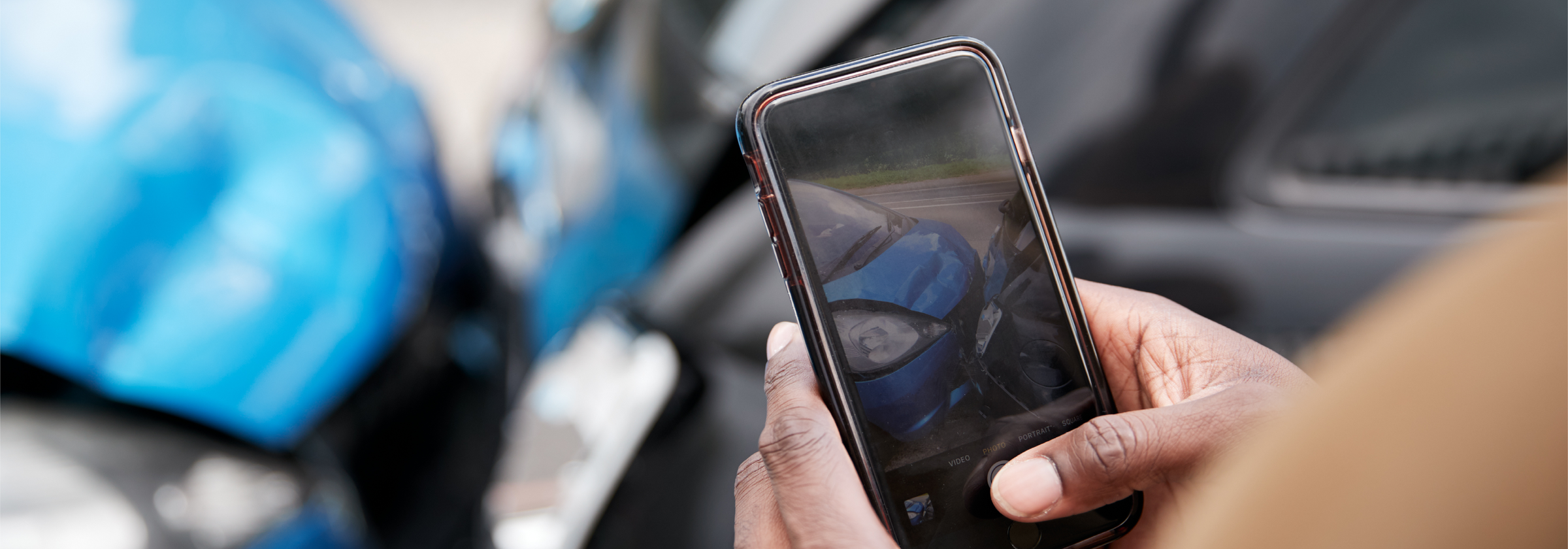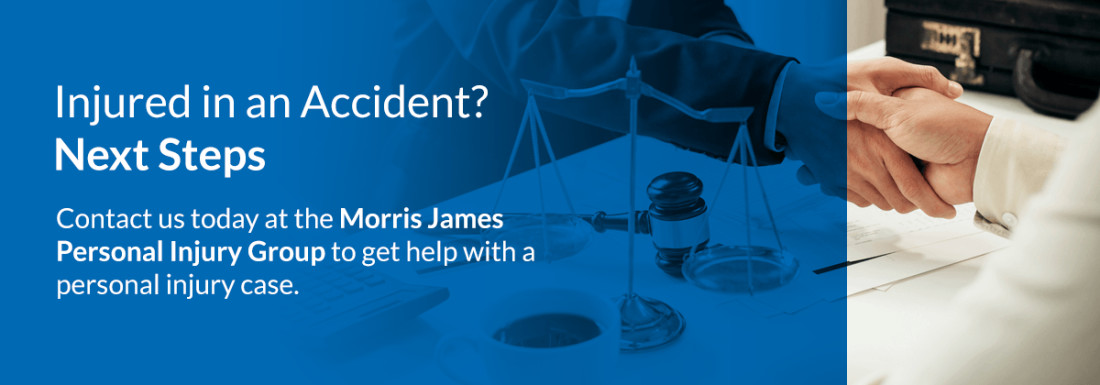If you are in a car accident, you may want to gather evidence to support a personal injury claim or lawsuit. Photos can be one of the best ways to document the scene of an accident, providing you with solid visual proof of what happened during and afterward. But what photos should you take to document the accident? What visual evidence should you gather to best support your case?
If you can gather photos, here are our tips on the evidence you will want to collect if you are injured.
What Types of Photos to Take After a Car Accident

You may be wondering what to do after a car accident. After you have been in a car accident, cover all your bases. Injuries, however small or large, can occur, and you should catalog them correctly for your case. Beyond your injuries, you will also want to document the scene of the accident, vehicle damage and other relevant details to the crash that could help you support your case.
In Delaware, common causes of car accidents include:
- Careless or aggressive driving
- Distracted driving
- Speeding
- Drowsy driving
- Driving under the influence of alcohol or drugs
- Poorly maintained roadways
Photographic evidence can help prove to an insurance company the cause of the accident and who was at fault.
We understand if your injuries are severe, first responders may have transported you from the scene, leaving you unable to take photos. If this has happened to you, see our tips below for how you can still gather evidence.
How Photos Can Help in a Personal Injury Claim
How can photos help you in a personal injury claim?
- Preserve evidence: Photos can help you preserve evidence of the car accident. As you are dealing with an insurance adjuster who is looking into your claim, these pictures will help prove your claim by showing the results of the accident.
- Paint a picture of the accident: Through photos, you can provide a visual of the scene of the accident, including details about the location, the weather conditions, positioning of the vehicles and more.
- Refresh your memory: Additionally, photos can help you refresh your memory when you are discussing the claim with the insurance company or when you are testifying about the car accident during a deposition or in court.
Snapping photos is one of the easiest ways to collect evidence of your car accident, so if you can take pictures, do so as soon as possible after the accident occurs.
What Types of Details to Capture
Deciding which details are relevant to photograph is not always an easy task in the moment. Many drivers learn they should have captured much more information long after the accident occurred. You should aim to snap as many photos as you can.
If you can get your hands on a device with plenty of storage space, this is the best option. If you only have access to a disposable camera or a device with little storage space, choose your pictures a little more carefully, optimizing your photos to include as many details as possible.
The following are several types of car accident photos to take.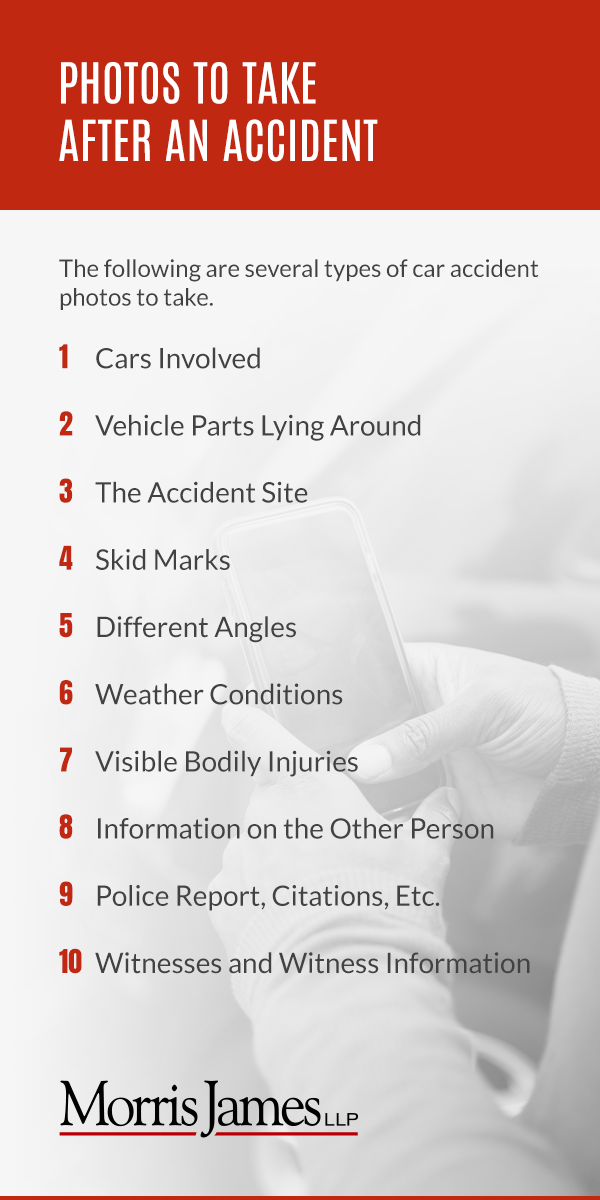
1. Cars Involved
One aspect of the crash you will want to obtain photographic evidence for is the damage to the vehicles involved. Physical evidence, rather than a description of the event, is often the best way to determine who is at fault for a car accident. For example, a dent where a car collided with yours could be the proof needed to declare the other driver at fault.
As such, you want to preserve this physical evidence for your injury claim. Keep physical evidence exactly the same as it was from the accident. If this is not possible, you should take pictures of the damage. Snap photos of both your vehicle and the other vehicles involved to illustrate all damage.
Physical objects and pictures are much more difficult to disprove than a verbal description of a memory.
2. Vehicle Parts Lying Around
Illustrating the damage resulting from a car accident is not only about what you can see on the vehicles themselves. You can also document damage by photographing the vehicle parts that are no longer intact.
After a crash, you are likely to find parts from the involved vehicles that have broken off and are lying nearby. Be sure to collect photographic evidence of any separated vehicle parts, including shattered glass.
3. The Accident Site
You will also want to take photos of the site of the accident. Did the accident occur at an intersection? In a parking lot? Take pictures that can show the setting of where the accident took place and the pattern of traffic during the accident. You will also want to take photos of the location or conditions of traffic signals and stop signs. These details can help paint a full picture of what and who caused the accident and how it impacted you.
4. Skid Marks
Can you see skid marks on the road at the scene of the crash? If so, be sure to document these with photos. Skid marks can indicate a driver was traveling too fast for the road conditions, failed to yield or hit the brakes suddenly.
If you cannot see any skid marks, you may still want to take a photo. A lack of skid marks can also prove a driver was distracted because they did not attempt to brake before the collision.
5. Different Angles
For each detail you are documenting, take pictures from a few different angles and distances, a minimum of three or four. If possible, take photos from one to five feet away for close-up shots, then 10 to 15 feet away for medium-distance photos, then, finally, 20 or more feet away for a long-distance shot if it is safe to do so. Make sure you also take a picture to capture your view directly before the accident.
While you are taking pictures from different angles and distances, do your best to keep in a common element or landmark to give your photos a scale and show the changes in distance.
You may also want to use different camera settings, such as pictures with and without flash, to account for how weather conditions and sunlight may affect your photos. A camera may have several features and settings for you to choose from, so experiment with these features to take some innovative photos, such as wide-angle pictures. You want a variety of photo samples that can give a more complete picture of the crash scene.
6. Weather Conditions
What were the weather conditions like during the time of your car accident? Weather and road conditions often play a role in auto collisions. If it was raining or snowing during the accident, you may be able to prove that the other driver was traveling too quickly for the dangerous conditions. If you believe weather conditions were part of the equation, do not forget to take photos of the sky and scenery.
7. Visible Bodily Injuries
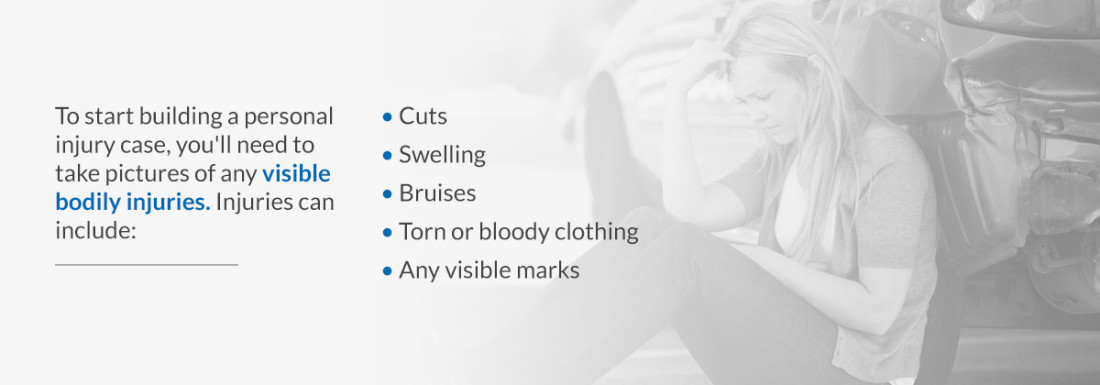
Convincing an insurance company that you sustained an injury in an accident will be far easier if you have actual evidence. To start building a personal injury case, you will need to take pictures of any visible bodily injuries. Injuries can include:
- Cuts
- Swelling
- Bruises
- Torn or bloody clothing
- Any visible marks
You will also want to obtain a medical record as soon as possible, so your doctor can confirm you were injured as severely as you claim. After you visit a doctor, you may also want to take photographic evidence of your injuries and any bandages, casts or splints you must wear for the healing process.
If you do not seek medical treatment right away or provide visual proof of the initial severity of your injuries, an insurance company may believe your injuries were not as severe as you claim, which could affect the compensation you receive.
8. Information on the Other Person
Though obtaining information on the person involved in the accident is not required for evidence in the case, it can be useful. Ask for their consent to take pictures of their license and insurance card so you can record and store their information as conveniently and accurately as possible. When building a personal injury case, it is better to have this information and not need it than need it and not have it.
9. Police Report, Citations, Etc.
What about the paperwork? Should you be collecting information about the police report, citations and other relevant documents?
Though you can gather this information later, you may want to consider having these reference numbers on your phone to make them easily accessible.
10. Witnesses and Witness Information
Lastly, you may wish to obtain information from witnesses with their consent. Witnesses can be incredibly valuable to your case. A witness can provide information that confirms what you claim happened, providing additional proof from the car accident that supports your story. A witness can even supply details and information you were not aware of that further proves someone else was at fault for the crash.
Collecting information from witnesses as soon as possible is crucial. Memories can fade quickly, and firsthand accounts can become contradictory if too much time has passed and details of the accident have become muddled. If there are witnesses to the crash, obtain their consent to document their information and their account of the event, so you can use the details they provide in your case.
Unless you have a device with limited storage, you cannot take too many pictures after an accident. Cover all your bases by snapping as many photos as you can.
Things to Consider When Taking Photos of the Accident Scene
What should you consider and keep in mind when taking photos of the car accident scene?
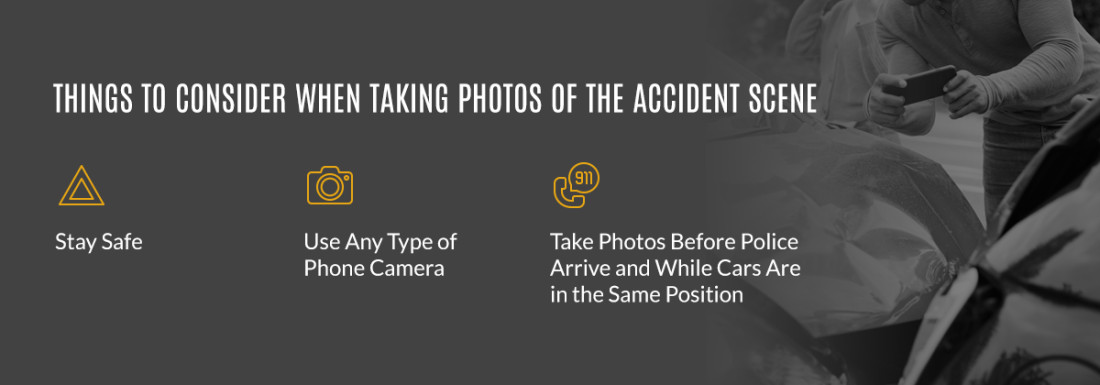
1. Stay Safe
Though it is best to take photos from several different angles and distances, be careful when doing so. Pay attention to any vehicles that may be driving past you in a high-traffic area. Even in an area with little traffic, like a back road, remain alert and exercise caution, as other drivers may not be expecting to come on the scene of an accident.
2. Use Any Type of Phone Camera
You do not have to be a professional photographer or own the newest high-tech camera to take the photos you need after a car accident. You can skip storing a camera in the glove box, and instead, use whatever device you have on hand that can take pictures.
In the age of technology, cameras on smartphones are becoming increasingly sophisticated, producing high-quality photos even in the dark. If a smartphone is not an option for you, you can also choose to purchase and use a disposable camera.
Regardless of what device or camera you choose to use, you should enable the device's ability to timestamp and date stamp your photos. For many devices, this is a default setting, but you should double-check that yours has this function before relying on it to document a car accident scene.
3. Take Photos Before Police Arrive and While Cars Are in the Same Position
Timing is crucial for obtaining photographic evidence. The best time to take photos of the accident is before the police arrive and before you and the other driver(s) move the vehicles out of the way of traffic. You want to capture the exact scene of the accident, so you should begin taking photos as soon as possible.
What If You Can't Take Photos at the Scene?
Unfortunately, you may find yourself in the situation of being unable to take any photos of the accident scene yourself. If your injuries are severe and prevent you from moving, you may have to rely on photographic evidence obtained another way.
1. Request Photos of the Crash Scene Taken by Someone Else
Odds are good that someone else has taken photos of the accident. You may be able to ask police officers and investigators who arrived at the scene for photographic evidence. The other driver or a witness may have also taken photos, so you may be able to request pictures of the accident from these other parties as well.
If the police contact a family member or friend about your accident, they may also show up to the scene and take pictures. Ask anyone who was at the scene of the accident if they took photos you can use.
2. Obtain Photos From a Traffic Cam or Security Camera
Depending on where your car accident took place, you may also be able to obtain photos or video evidence from a security camera or traffic camera. A business security camera, for example, may have captured the accident on tape, and the business owner may allow you to obtain and use this evidence for your case.
Injured in an Accident? Next Steps
Have you gotten hurt in a car accident? Maximize your injury claim by hiring a car accident attorney in Delaware. Contact us today at the Morris James Personal Injury Group to get help with a personal injury case.
